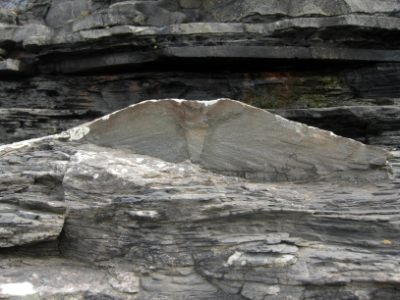When is a volcano, not a volcano? When it is a sand volcano?
01.12.2021Along our coast from Doolin to the Shannon Estuary there are a few nice examples of sand volcanoes. Sand volcanoes are low conical mounds, often with a shallow central depression, resembling a volcano and its crater. Internally they are made of layers of sand and have a central vertical core, also originally composed of sand, all now turned to rock as sandstone.
They are found within the rock layers so have been there for over 300 million years, and they range in size from a couple of centimetres to over a metre in diameter. Sand volcanoes (also known as ‘sand boils’) are formed by water and sand, not lava. They generally form in areas where there is a high rate of sedimentation, such as a delta, where successive large amounts of sand and mud are transported by rivers into the sea after heavy rain or storms. Water can become trapped and buried with the sediment. The weight of successive layers of sediment puts pressure on the underlying water-laden layer raising the water pressure which eventually erupts onto the seafloor. As the water pours onto the seafloor it carries some of the sand with it and deposits layers of the sand around the vent, building up the cone shape.

The weight of the sediment alone is often enough to trigger a sand volcano; however, sand volcanoes are also known to be formed during earthquakes, as the seismic shock can cause sediment to become liquidized and unstable, forcing water to escape from the sediment. You can get an idea of what happens if you stand on a beach near the waves and jiggle your feet; you will see water gathering around your feet, this is a result of the grains of sand and the water re-organizing themselves under the pressure of your weight, forcing the water to the surface. So, along with other evidence, these sand volcanoes tell us that the sand that now forms the rocks from Doolin to the Shannon Estuary was deposited quickly, on a delta (search for the Mississippi or Ganges deltas for comparison) and may have been affected by earthquakes. Earthquakes would have been common at that time as the large continent we were on was colliding with another one. Also, for those of you disappointed by the fact that they are not real volcanoes, we do have some volcanic rocks in Clare, as 330-million-year-old lavas are known from the Quin-Kilkishen area. Thankfully, these areas are geologically more tranquil these days, however, the enormous power of the Atlantic Ocean now batters those rocks and bit by bit returns them back to the sea, where they will ultimately be buried and turned to rock again.
Dr. Eamon Doyle, geologist for the Burren and Cliffs of Moher UNESCO Global Geopark, Clare County Council.